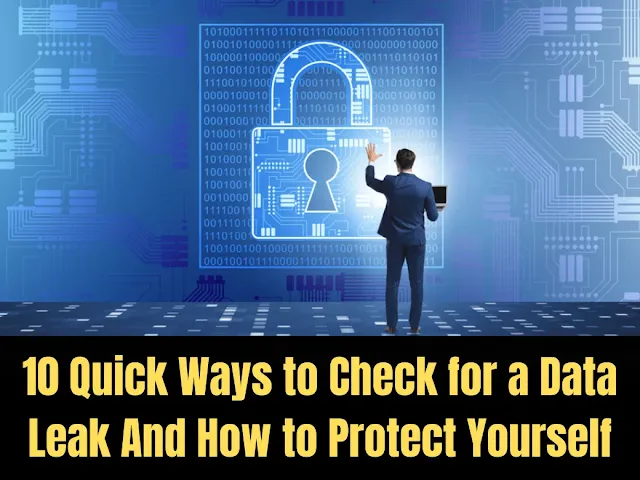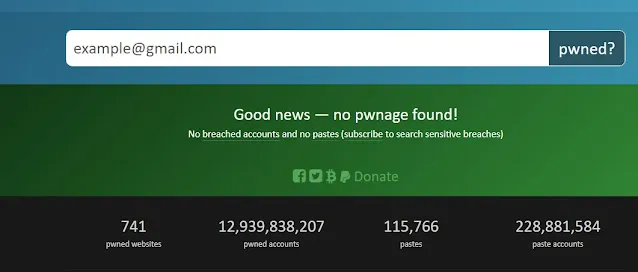Our personal information faces an increasing number of risks in the modern, interconnected world. With data breaches making headlines on a regular basis, it's more important than ever to safeguard our sensitive data and online accounts. While total protection is impossible, practicing strategic vigilance through routine security checks offers invaluable peace of mind. By catching issues early, we can cut risks off at the pass and limit potential damage from data exposure. In this post, we'll outline 10 straightforward yet effective methods for regularly auditing your digital footprint and monitoring for signs of unauthorized access or leaks. A little time invested in these quick checks can go a long way towards fortifying your online defenses. So whether you're simply more security-conscious or have concerns following a recent breach, keep reading for our top tips to help you protect your privacy.
10 Quick Ways to Check for a Data Leak - And How to Protect Yourself
In this post, we will outline 10 quick and effective methods for checking your online accounts and data for any potential breaches or unauthorized access. We'll also explain the steps you should take to protect your sensitive information and strengthen your digital defenses. Implementing even a few of these proactive monitoring practices can help you detect compromises early on and minimize the impact of any security incidents. So, let's get started with some simple ways to audit your digital footprint and accounts.
1. Google Search Your Email Address
One of the simplest yet overlooked checks is Googling your primary email address enclosed in quotes, like "email@domain.com". This searches only for exact matches and can surface if your address was exposed publicly, say through a data breach. If found, further investigate where it's listed and contact the site administrator to request removal of any personal details. You can also try variations like omitting quotes in case of minor errors.
2. Verify Credentials with HaveIBeenPwned
To gain a more holistic view beyond search engines, check popular Data Breach notification sites like HaveIBeenPwned. This monitors data from extensive security breaches and notifies you if any accounts using your email address or passwords were accessed without authorization. Knowing exposed logins lets you prioritize strong, unique password changes to safeguard sensitive profiles.
3. Utilize Dark Web Monitoring Tool
Not all websites are indexed by standard search engines. Many malicious cybercriminals trade stolen information privately on the "dark web" hidden from public view. Google offers a free Dark Web Monitoring service to scan if your credentials appear in underground hacking forums. While the effectiveness can be debated, as a free additional protection layer, it's worth enabling alerts through your Google account settings.
4. Configure Login Alerts for All Accounts
Beyond reactive checks, proactive monitoring strengthens your response capabilities. Enable login notifications across major profiles informing of access attempts from unfamiliar devices or IP addresses. You should also periodically test logging in from a new location to verify alerts function properly. Catching unauthorized access right away allows quickly changing compromised credentials.
5. Adopt a Trusted Password Manager
Reusing passwords across different websites leaves you vulnerable if a single site is hacked. A password manager like LastPass generates long, randomized credentials that are impossible to guess or crack. It securely stores login information behind a master password. Plus, its breach monitoring alerts you to exposed sites requiring changes. Using unique, complex passwords for each account significantly improves your defenses.
Here's some top trusted password managers:
LastPass - One of the most popular options. It has a great interface, strong security, and is available on all platforms. The free version lets you use it across all your devices.
1Password - Often rated the top password manager. It has exceptionally strong security and easy ways to generate secure passwords. Works seamlessly across Windows, macOS, iOS, and Android.
Dashlane - Another top choice known for its security features like regular security audits. Dashlane is very user-friendly and works on all devices. Excellent at protecting passwords on public Wi-Fi.
Keeper - A great all-around option that emphasizes security with zero-knowledge encryption. Has long password generations and works across 6 devices. User-friendly web vault.
Bitwarden - A very good free and open-source option. Cross-platform compatibility, 2FA security, and available on all major devices. Robust premium version too.
LastPass - Simple and effective free password manager. Very user-friendly interface and works across multiple platforms. Strong underlying security.
NordPass - Relatively new but well-regarded. High security standards, great design, and works on all devices. Competitively priced premium version.
6. Regularly Check Junk/Spam Folders
Even the best-configured email filters may occasionally direct high-priority security alerts into junk or spam folders. A weekly search of these folders for keywords like "account access" ensures no breach warnings slip through cracks. Also monitor for unusual changes in spam patterns, which sophisticated hackers sometimes employ in "spam bombing" to covertly access accounts.
7. Monitor Banking and Payment Activity
Given your financial information poses among the gravest risks if stolen, vigilantly monitor transactions across linked credit/debit cards and bank accounts for irregular or unauthorized activity. Any payments you suspect as potentially fraudulent should immediately trigger fraud alerts and password resets. Acting swiftly prevents thieves from depleting funds or establishing further harmful activity in your name.
8. Audit Connected Devices and Profile Access
Taking a broader view, periodically review all devices authorized to access Google, social media and other major account profiles that may contain sensitive personal details. Look for any unfamiliar or obsolete entries and remove permissions. Close unnecessary browser sessions outright instead of just signing out for added assurance no sessions remain open.
9. Regularly Check Credit Reports
Minor clues indicating identity theft include hard credit inquiries not tied to your account applications or an unexpected dip in credit scores due to increased account balances or late payments. Monitoring reports from Experian, TransUnion and Equifax at minimum monthly helps catch issues early for addressing with banks and credit bureaus to begin recovery. Knowledge equips prevention of future damages, too.
10. Stay Updated on Breach Announcements
Perhaps most important in your ongoing digital security regimen is proactively following reputable data breach news sources. Configure email alerts directly from services like HaveIBeenPwned about breaches potentially involving your details. You may also join mailing lists from credit bureaus, banks and tech/privacy websites covering emerging threats. Staying informed allows taking timely action if needed like password changes.
Conclusion
While total protection of your personal data online can never be guaranteed, implementing comprehensive monitoring and security practices puts you in the strongest position to detect potential breaches early and take prompt action. Maintaining vigilance through regular online checks, promptly changing exposed passwords, controlling access to your accounts, and configuring login alerts are proactive steps that minimize risks. By incorporating these straightforward yet powerful habits into your digital routine, you gain visibility over your online footprint and fortify your defenses. While data leaks may still occur despite best efforts, this approach empowers rapid response to curb resulting damage as much as possible. Prioritizing digital safety contributes significantly to your overall online well-being and peace of mind in today's interconnected world.
%20(4).png)





